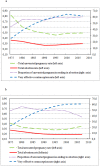Effectiveness of family planning policies: the abortion paradox
- PMID: 24670784
- PMCID: PMC3966771
- DOI: 10.1371/journal.pone.0091539
Effectiveness of family planning policies: the abortion paradox
Abstract
Objective: The relation between levels of contraceptive use and the incidence of induced abortion remains a topic of heated debate. Many of the contradictions are likely due to the fact that abortion is the end point of a process that starts with sexual activity, contraceptive use (or non-use), followed by unwanted pregnancy, a decision to terminate, and access to abortion. Trends in abortion rates reflect changes in each step of this process, and opposing trends may cancel each other out. This paper aims to investigate the roles played by the dissemination of contraception and the evolving norms of motherhood on changes in abortion rates.
Methods: Drawing data from six national probability surveys that explored contraception and pregnancy wantedness in France from 1978 through 2010, we used multivariate linear regression to explore the associations between trends in contraceptive rates and trends in (i) abortion rates, (ii) unwanted pregnancy rates, (iii) and unwanted birth rates, and to determine which of these 3 associations was strongest.
Findings: The association between contraceptive rates and abortion rates over time was weaker than that between contraception rates and unwanted pregnancy rates (p = 0.003). Similarly, the association between contraceptive rates and unwanted birth rates over time was weaker than that between contraceptive rates and unwanted pregnancy rates (p = 0.000).
Conflict of interest statement
Figures
References
-
- Marston C, Cleland J (2003) Relationships between contraception and abortion: a review of the evidence. International Family Planning Perspectives 29: 6–13. - PubMed
-
- Erfani A (2011) Induced abortion in Tehran, Iran: estimated rates and correlates. International perspectives on sexual and reproductive health 37: 134–142. - PubMed
-
- Serbanescu F, Stupp P, Westoff C (2010) Contraception matters: two approaches to analyzing evidence of the abortion decline in Georgia. International Perspectives on Sexual & Reproductive Health 36: 99–110. - PubMed
-
- Bongaarts J, Westoff CF (2000) The potential role of contraception in reducing abortion. Studies in family Planning 31: 193–202. - PubMed
-
- David HP (1992) Abortion in Europe, 1920-91: a public health perspective. Studies in Family Planning 23: 1–22. - PubMed
Publication types
MeSH terms
LinkOut - more resources
Full Text Sources
Other Literature Sources
Medical


